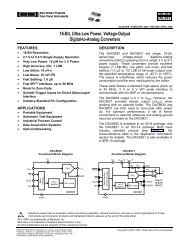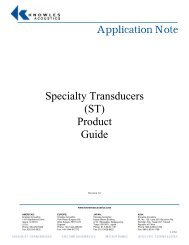DAC7631 - dreamm
DAC7631 - dreamm
DAC7631 - dreamm
You also want an ePaper? Increase the reach of your titles
YUMPU automatically turns print PDFs into web optimized ePapers that Google loves.
<strong>DAC7631</strong><br />
<strong>DAC7631</strong><br />
<strong>DAC7631</strong><br />
SCK<br />
CLK<br />
CLK<br />
CLK<br />
DIN<br />
SDI<br />
SDO<br />
SDI<br />
SDO<br />
SDI<br />
SDO<br />
CS<br />
CS<br />
CS<br />
CS<br />
To<br />
Other<br />
Serial<br />
Devices<br />
FIGURE 14. Daisy-chaining <strong>DAC7631</strong>.<br />
DAC updates; i.e., the LDAC pin can be driven with a<br />
separate signal, such as a timing clock, which need not be<br />
directly related to the serial data timing. This makes it easy<br />
to synchronize <strong>DAC7631</strong> updates with external events or<br />
with other DACs.<br />
Note that CS and CLK are combined with an OR gate, which<br />
controls the serial-to-parallel shift register. These two inputs<br />
are completely interchangeable. In addition, care must be<br />
taken with the state of CLK when CS rises at the end of a<br />
serial transfer. If CLK is LOW when CS rises, the OR gate<br />
will provide a rising edge to the shift register, shifting the<br />
internal data one additional bit. The result will be incorrect<br />
data and possible selection of the wrong input register(s). If<br />
both CS and CLK are used, CS should rise only when CLK<br />
is HIGH. If not, then either CS or CLK can be used to<br />
operate the shift register. See Table II for more information.<br />
CS (1) CLK (1) LOAD RST SERIAL SHIFT REGISTER<br />
H (2) X (3) H H No Change<br />
L (4) L H H No Change<br />
L ↑ (5) H H Advanced One Bit<br />
↑ L H H Advanced One Bit<br />
H (6) X L (7) H No Change<br />
H (6) X H ↑ (8) No Change<br />
NOTES: (1) CS and CLK are interchangeable. (2) H = Logic HIGH.<br />
(3) X = Don’t Care. (4) L = Logic LOW (5) = Positive Logic Transition.<br />
(6) A HIGH value is suggested in order to avoid a “false clock” from<br />
advancing the shift register and changing the shift register. (7) If data is<br />
clocked into the serial register while LOAD is LOW, the DAC register will<br />
change. This will corrupt the data in each DAC register that has been<br />
erroneously selected. (8) Rising edge of RST causes no change in the<br />
contents of the serial shift register.<br />
TABLE II. Serial Shift Register Truth Table.<br />
SERIAL-DATA OUTPUT<br />
The Serial-Data Output (SDO) is the internal shift register’s<br />
output. For <strong>DAC7631</strong>, the SDO is a driven output and does<br />
not require an external pull-up. Any number of <strong>DAC7631</strong>’s<br />
can be daisy chained by connecting the SDO pin of one<br />
device to the SDI pin of the following device in the chain,<br />
as shown in Figure 14.<br />
DIGITAL TIMING<br />
Figure 15 and Table III provide detailed timing for the<br />
digital interface of the <strong>DAC7631</strong>.<br />
DIGITAL INPUT CODING<br />
The <strong>DAC7631</strong> input data is in Straight Binary format. The<br />
output voltage is given by Equation 1:<br />
V V L<br />
OUT<br />
REF<br />
VREFH – VREFL • N<br />
65,<br />
536<br />
= + ( )<br />
where N is the digital input code. This equation does not<br />
include the effects of offset (zero-scale) or gain (full-scale)<br />
errors.<br />
DIGITALLY-PROGRAMMABLE<br />
CURRENT SOURCE<br />
The <strong>DAC7631</strong> offers a unique set of features that allows a<br />
wide range of flexibility in designing applications circuits<br />
such as programmable current sources. The <strong>DAC7631</strong> offers<br />
both a differential reference input, as well as an open-loop<br />
configuration around the output amplifier. The open-loop<br />
configuration around the output amplifier allows a transistor<br />
to be placed within the loop to implement a digitallyprogrammable,<br />
unidirectional current source. The availability<br />
of a differential reference allows programmability for<br />
both the full-scale and zero-scale currents. The output current<br />
is calculated as:<br />
I<br />
OUT<br />
⎛ VREFH VREFL<br />
= ⎛ ⎝ ⎜ – ⎞ ⎛ N ⎞⎞<br />
⎜<br />
⎟ • ⎜ ⎟<br />
⎝ RSENSE<br />
⎠ ⎝ 65,<br />
536⎠⎟<br />
⎠<br />
V L/<br />
R<br />
+ ( )<br />
REF<br />
SENSE<br />
(1)<br />
(2)<br />
®<br />
<strong>DAC7631</strong><br />
16















